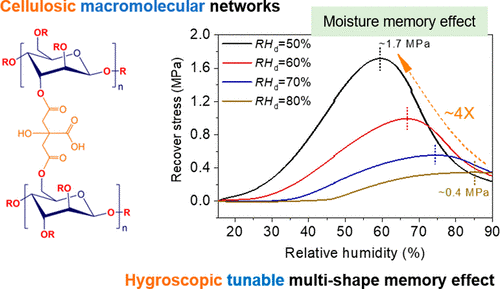Shape memory polymers with stimuli-triggered, programmable shape changes have enabled a plethora of applications such as smart textiles, soft robotics, and biomedical devices. In particular, tunable multishape memory polymers are gaining increasing attention due to their advantage of memorizing complex multiple shapes with tunable transition temperatures from one material composition. Such tunable multishape memory effects, however, have been exclusively associated with the thermomechanical behaviors of materials, significantly limiting their applications in heat-sensitive biomedical scenarios where excessive energy input may cause potential damage to cells and surrounding tissues.
Prof. Dr. Siya Huang’s team from theInstitute for Advanced Study at Shenzhen University reported a humidity-regulated tunable multishape memory effect in cellulosic supramolecular networks, which has been published inACS Macro Lettersrecently. Boyan Du, a master's student at the Institute for Advanced Study is the first author.
This work reports the hygroscopic and tunable multiple shape memory effects of cellulose derivative polymers with supramolecular mesophase networks. The hydrogen-bonded supramolecular network exhibits remarkable mechanical response over a wide range of relative humidity. Under the independent control of a wide range of adjustable relative humidity, the polymer exhibited double, triple and quadruple shape memory behavior at room temperature, and showed a unique humidity memory effect. This novel humidity memory effect is similar to the temperature memory effect of traditional thermomechanical shape memory materials, which offers practical benefits for the precise regulation of programmable shape memory behaviors. In addition, the polymers show excellent properties in terms of shape fixation rate, recovery rate and cycle stability. The underlying mechanism of this new type of humidity-control multishape memory effect was also elucidated, which provides a theoretical basis and guidance for developing more nonthermal multishape memory polymers. This humidity-regulated multishape memory polymer is expected to perform autonomous, fast and programmable shape change in scenarios with a constant temperature, showing great potential in biomedical fields.
This work was supported by the National Natural Science Foundation of China and the Basic and Applied Basic Research Foundation of Guangdong Province.
Publication link:https://doi.org/10.1021/acsmacrolett.3c00239



